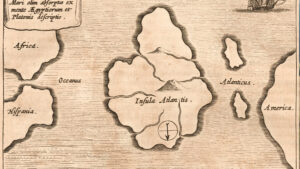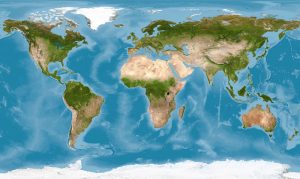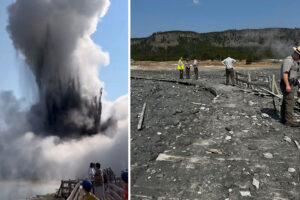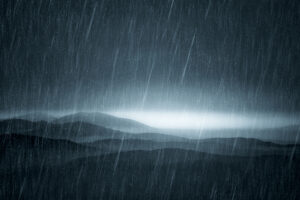For hundreds of years, the Bermuda Triangle has been synonymous with mysterious disappearances. This infamous region in the western Atlantic Ocean, bordered by Miami, Bermuda, and Puerto Rico, has become a household term for a place where things simply…disappear. In the last century, 50 ships and 20 airplanes have either vanished, crashed, or sunk here. What makes this 1,294,994 sq km region apparently so dangerous?
Author Vincent Gaddis coined the phrase “Bermuda Triangle” in the 1960s in an article he wrote for a famous pulp magazine called Argosy. It earned him a less-than-favorable reputation as someone who promoted “crackpot claims” and ignored normal explanations. Not long after, other writers began to weigh in, propelling the region into notoriety. It became a catch-all for the paranormal, from alien abductions to the lost city of Atlantis.
Talk of the strange happenings in the Triangle dates back all the way to the Age of Discovery. Christopher Columbus was sailing through the triangle to Guanahani (now called San Salvador Island in the Bahamas) when he described seeing a light, shaped like a candle flame, vanish into the sea. At the same time, his compass went haywire.
In the early 1600s, a ship famously went down off the shores of Bermuda. It was supposedly the inspiration for Shakespeare’s The Tempest. The 1800s noted an increase in the number of disappearing ships in that area. The weirdness has continued to the present day.

Photo: NOAA
Famous incidents
The Carroll A. Deering was a schooner transporting coal from Puerto Rico to Rio de Janeiro in 1920. It successfully reached Rio, then turned around. On January 29, a lightship keeper named Captain Jacobson saw the Deering crew “milling around” oddly when it passed the lightship. Soon after, it somehow ran aground on the Diamond Shoals off North Carolina.
It was found two days later, on January 31. No one was on board, but the sails were set. The ship’s log, some equipment, personal belongings, and a couple of lifeboats were missing, indicating a controlled evacuation of the vessel. Some wooden pieces of the Deering washed ashore nearby.

The Carroll A. Deering on January 28, 1921. Photo: United States Coast Guard
A U.S government investigation found several possibilities. First, the crew apparently disliked their captain, W.B Wormell, so a mutiny may have occurred. Second, a hurricane passed through the area around that time. However, the Deering was sailing away from the storm.
Thirdly, pirates or smugglers (particularly Russians) were hijacking American ships around that time. They took them back to the USSR or used them for rum-running during Prohibition.
The most popular theory, of course, (which the government does not subscribe to) is the malevolent influence of the Bermuda Triangle. Although the Triangle is more than 200km from the shipwreck, many still believe that it sailed through that cursed area and took the lives of the crew.
Aircraft have also disappeared in that region. The first involved Flight 19, on December 5, 1945. Five TBF Avenger torpedo bombers carrying 14 airmen were on a standard training mission. Most of the men were trainee pilots, hoping to complete the exercise in order to graduate. They were to fly 197km east from Fort Lauderdale, 117km north, then 193km back west, while learning to release bombs or torpedoes. The mission was supposed to take at least three hours. This routine exercise soon turned into a mad scramble to find land and safety.

An Avenger bomber squadron over Virginia. Photo: National Archives and Records Administration
The flight’s leader, Lt. Charles C. Taylor, was hesitant and uneasy that fateful morning. He tried to get out of the exercise, but his superiors denied his request because he lacked a good enough reason. Coincidence or foresight? Was he in some mental funk? Who knows? But his transmissions to the base at Fort Lauderdale did shed some light on what went wrong. Although they took off in good weather, with 20km visibility, the skies soon turned dark and tumultuous.
Taylor radioed the base saying, “Both of my compasses are out…and I am trying to find Fort Lauderdale…I don’t know how far down…don’t know how to get to Fort Lauderdale.”
“Everything looks strange, even the ocean…”
Some of Taylor’s transmissions were much weirder. “Everything looks strange, even the ocean,” he said. “We are entering white water, nothing seems right.”
When he was over the Bahamas, he thought he was flying over the Florida Keys. This miscalculation caused him to fly in the wrong direction, much to his students’ dismay. He refused to fly west despite suggestions from the younger airmen. His last transmission reported that they were going to ditch their aircraft when they ran out of gas.
They were never heard from again. Search-and-rescue efforts did not recover any bodies or wreckage. Even one of the two seaplanes searching for them disappeared…
The 1940s featured more than six plane incidents. On December 28, 1948, a Douglas DST passenger airline flying from San Juan to Miami vanished. There were 29 passengers and 3 crew members on board. Before the flight even started, the plane was experiencing technical issues. The landing gear warning light was malfunctioning, and the batteries were low. Yet somehow, it cleared to fly after some tweaks here and there.

Douglas DST airliner. Photo: United States Library of Congress
The weather was pleasant enough that day. The flight proceeded normally until communications started to act up. Airports in New Orleans picked up their transmissions, not Miami. The towers had to repeatedly forward their messages to the correct party. No one noted changes in weather. Eventually, the plane just stopped receiving further instructions and vanished. No bodies or wreckage ever turned up. A downed Douglas DST airliner did turn up in the Triangle, but we still don’t know whether it was the same aircraft.
In 1967, a hotel owner named Dan Burrack took his friend, Father Patrick Horgan, on his cabin cruiser, the Witchcraft, to admire the Christmas lights on the Miami shoreline. The Miami coast guard got a distress call from Burrack stating that his boat had hit something. They arrived 20 minutes later and found no one. The coast guard searched 3,100 sq km but found neither boat nor bodies.

Sunken plane. Photo: Kichigin/Shutterstock
In 1970, experienced pilot Bruce Gernon and his father took off in their Bonanza aircraft and flew into an eerie “electronic fog”. All the navigational equipment malfunctioned as a thick fog/cloud tunnel enveloped the little plane.
Luckily, they managed to escape. They arrived in Miami half an hour faster than they expected. They had traveled more than 160km, thanks to the tunnel’s high-speed winds. Some researchers believe that not even high winds could have carried them so far so quickly.
Explanations
One of the most solid explanations of the Triangle’s wacky weather, the likely cause of so many incidents, is the presence of the Gulf Stream. The Gulf Stream is a powerful ocean current running from the Gulf of Mexico along the eastern U.S. to Newfoundland. The Stream’s warm water interacts with the cold water from the North Atlantic, causing a quick release of moisture. This, in turn, rapidly generates storms and other intense features like waterspouts and massive waves.
Simon Boxall of the University of Southampton believes that rogue waves definitely occur. The Stream most carries away ship or plane wreckage at its consistent speed of 6.5kph. By the time that rescue efforts arrive, evidence is long gone.

Shipwreck in the Bermuda Triangle. Photo: Rachel K H/Shutterstock
Scientists also suggest the possible presence of underwater methane pockets. In 2016, scientists discovered underwater gas craters with the potential to sink whole vessels. These same scientists suggested that the Bermuda Triangle could contain these craters. The Triangle is home to a very deep trench called the Puerto Rico Trench, in the Atlantic’s deepest area, the Milwaukee Depth. While the theory is reasonable, no gas craters have turned up in the Triangle.
In 1979, John Hutchison suggested something he modestly called the Hutchison Effect. He recreated the thick fog by forcing different electromagnetic fields to interact. This would explain why vessels and planes become so disoriented and why navigational equipment goes awry.
Human error is often the case in most tragedies. Sometimes, it may be the mental state of the captain or pilot, other times, simply faulty equipment. The region’s unusually extreme weather certainly demands caution.
At the same time, the Bermuda Triangle is one of the world’s busiest shipping lanes. The vast majority of vessels pass through unscathed. The likeliest explanation is that a certain number of disappearances in such a well-trafficked region is statistically likely. The Bermuda Triangle doesn’t seem to have more shipwrecks and plane crashes than comparably sized areas that are as busy. Maybe, thanks to a tabloid writer’s deft hand with a phrase, we just notice them more.






